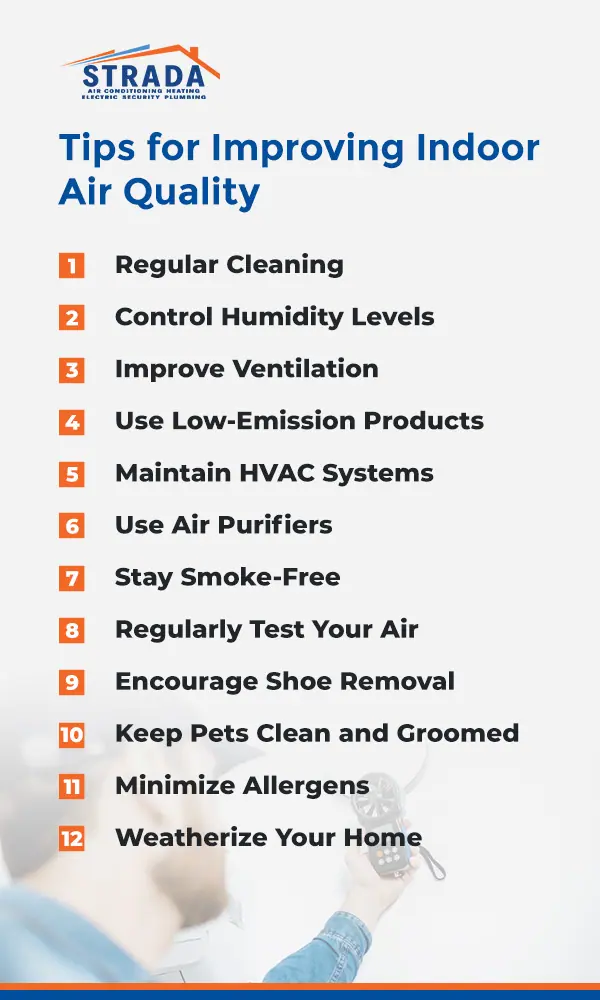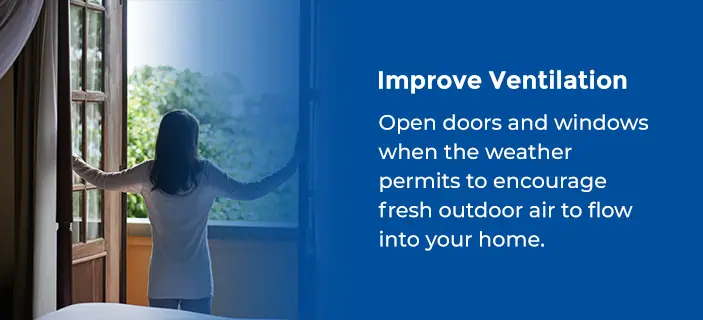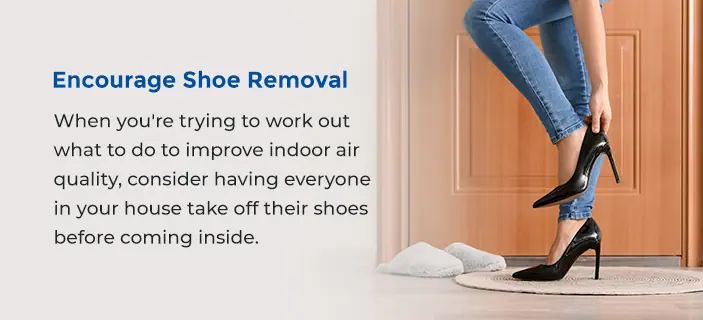
With so much dust and debris constantly collecting in your home, how do you improve indoor air quality? Exploring and understanding various strategies to improve indoor air quality will help you keep yourself and your household safe and healthy.
Regularly cleaning, controlling humidity, dusting and other tasks can minimize allergens and reduce mold growth. Additionally, low-emission products, heating and air conditioner maintenance, and air purifiers are effective solutions for improving your home’s air. Learn more about the different ways to improve indoor air quality below.
Indoor air quality is the air quality in and around buildings and homes — your home has its own indoor air quality that affects your health. Exposure to air pollutants reduces your quality of life, making breathing harder or increasing allergy symptoms. There are visible long-term and short-term health effects related to poor indoor air quality. If you want to make your home as safe and comfortable as possible, you should invest in improving your house’s indoor air quality.
Getting better home air quality takes time, effort and habit. If you want to improve your indoor air quality, you need to focus on these three areas:

Good air habits can help you breathe easier and reduce your long-term air conditioning expenses. If you want to learn several ways to improve indoor air quality at home, check out these tips.
A dust-free and clean home is the foundation for good indoor air quality. Regular cleaning routines, including vacuuming carpets, dusting surfaces and mopping floors, can help remove dust, dirt and allergens from your living space. Give extra attention to areas that accumulate debris and dust, such as ceiling fans, window sills and blinds — these areas are tricky to clean and easy to neglect when cleaning floors and other surfaces.
A vacuum cleaner equipped with a high-efficiency low particulate (HEPA) filter can improve air quality by trapping small particles that conventional vacuums might release back into the air. Remember to clean or replace the vacuum filter regularly to maintain its effectiveness.
Maintaining appropriate humidity levels is another way you can improve indoor air quality. Keeping your indoor humidity levels in check is essential for stopping and preventing mold growth and reducing the presence of allergens. Use a moisture or humidity gauge to monitor indoor humidity, aiming for a range of 30% to 50% inside. If the humidity levels are too high, it can affect your heating, ventilation and air conditioning (HVAC) system, reducing the system’s efficiency and affecting your comfort.
Be mindful of areas prone to excess moisture — such as kitchens and bathrooms — and use exhaust fans to reduce humidity buildup. Repair any leaks promptly to prevent water damage and mold growth. These problems add to your expenses and can impact the health and comfort of your household. A dehumidifier is an excellent way to remove excess moisture from your rooms. Conversely, humidifiers can help add moisture back into the air as needed.

Adequate ventilation is one of the best ways to improve indoor air quality. Good ventilation is vital for circulating fresh air and reducing indoor air pollutants. Open doors and windows when the weather permits to encourage fresh outdoor air to flow into your home. Cross ventilation — achieved by opening windows on opposite sides of the house — can enhance air circulation and improve indoor air quality.
In areas where the outdoor air quality may be poor, like near construction sites or busy roads, using high-quality window screens can help filter out larger debris and pollutants while maintaining ventilation. If this is not possible for you, consider investing in alternate solutions like air purifiers to protect your home’s indoor air quality.
Many household products — furniture, paints and cleaning agents — can release harmful volatile organic compounds (VOCs) into the air. One of the ways we can improve indoor air quality is by being more selective with the products we use. Choose VOC-free or low-VOC products whenever possible to reduce air pollutants. When choosing cleaning supplies, adhesives and paints, look for eco-friendly labels and certifications.
When purchasing new furniture or household items, allow them to air out in a well-ventilated area or outside before bringing them into your living space. This step can help reduce the initial release of VOCs and other chemicals. You’ll keep that new-factory chemical smell out of your spaces and protect them from indoor air pollution.
An important step for improving indoor air quality at home is regular professional HVAC maintenance for your system. Schedule professional HVAC inspections and cleanings at least once a year to ensure the system operates efficiently and does not circulate dust or allergens.
You can help enhance air quality by regularly swapping out your air filters, cleaning vents and clearing debris from your outdoor unit. Any dirt, dust and debris that’s allowed to build up in your system prevents it from working efficiently and cleaning your air. Standard air filters should be replaced every one to three months, while HEPA filters may require more infrequent replacement, depending on usage, air quality and manufacturer’s instructions.
Air purifiers are practical tools for improving the indoor air quality of a room or space. Air purifiers can help capture and remove airborne allergens, particles and pollutants.
When selecting an air purifier, consider the size of the room and the specific pollutants you want to target. HEPA air purifiers are particularly effective at capturing small particles, including dust, pet dander, mold spores and pollen. HEPA filters are designed to catch 99.97% of air particulates and are excellent for homeowners looking to thoroughly purify their home air.
Keeping smoke out of your home is another strategy you can use to improve your indoor air quality. Smoking indoors significantly degrades indoor air quality by releasing harmful chemicals and particulates into the air. Establishing a smoke-free environment inside your home can drastically improve air quality and reduce the risk of respiratory issues for smokers and non-smokers.
Encourage smoking guests or residents to smoke outside and provide designated outdoor areas away from entrances and windows to prevent smoke from entering the house. The more you can prevent smoke from getting inside and settling, the better you’ll be able to breathe.
Consider using indoor air quality monitors to check the levels of pollutants in your home regularly. These monitors can detect the presence of common indoor pollutants such as VOCs, carbon dioxide and particulate matter. By tracking indoor air quality, you can identify potential issues and take appropriate actions to improve them.
Additionally, watching for radon and carbon monoxide is vital — they’re silent but potentially deadly indoor air pollutants. Radon is a radioactive gas that can seep into homes from the ground. Carbon monoxide is a colorless, odorless gas produced by incomplete combustion in fuel-burning appliances.
Install radon test kits and carbon monoxide detectors in your home to monitor these pollutants regularly. Seek professional assistance if elevated levels are detected, as both carbon monoxide and radon can have serious health implications for those exposed. Replace any batteries as needed to ensure your testing devices are constantly monitoring your home.

When you’re trying to work out what to do to improve indoor air quality, consider having everyone in your house take off their shoes before coming inside. It’s less time-intensive than other methods on this list and is an excellent stepping-stone to help you build better habits around home air quality.
Encouraging shoe removal at your home’s entrance can prevent outdoor allergens, dirt and pollutants from being tracked inside. Set up a designated area for shoes near the door and provide a shoe rack or shoe storage to make it convenient for household members and guests to remove their shoes upon entering. Make sure to clean the shoe area when you clean the rest of the home — having all that outdoor buildup inside can still reduce the air quality at your home’s entrance.
If you have pets, regular grooming and cleaning are ways you can improve your indoor air quality. Pet dander and fur are common allergens — as your pets sleep, play and shed, these allergens get spread throughout the house.
Brush your pets outside regularly if possible to minimize the amount of dander released indoors. Additionally, keep pet bedding, toys and litter boxes clean to reduce further allergens. Your pets will be happy to be so clean, and you’ll breathe easier with regular pet grooming.
Pet dander isn’t the only thing you need to watch out for — removing allergens is also an effective way to clear the air. Allergens and dust mites can trigger allergies and respiratory issues, especially in individuals with lung sensitivities. To reduce their presence, take the following steps:
Gaps and damaged seals in your home allow exterior air to flow freely between the inside and the outside. While controlled window openings can help ventilate your space, having all these gaps lets allergens, debris and particulates inside, putting strain on your air conditioning and heating system. Taking proper measures to seal these gaps and weatherize your home can help keep your indoor air quality up and your home’s temperature comfortable.
Use caulking, weather-stripping, blown-in insulation and storm windows to reduce the amount of exterior air and particulates entering your home. Check all entry points around windows, doors and garages to ensure they’re tightly sealed.
Weatherizing will help protect you from outdoor pollutants, but not indoor ones — ensure you’re following the above tips to keep indoor pollutants down if you want to maximize air quality.

By prioritizing indoor air quality and implementing these strategies, you can ensure your home provides a healthy and comfortable environment for you and your loved ones to breathe easy and thrive. With conscious efforts, you can enjoy the benefits of clean and fresh air indoors, supporting your overall health and enhancing your quality of life.
Strada Services has been a trusted expert in air conditioning and indoor air quality services since 2003. We deliver affordable, high-quality HVAC and electric services so that you can enjoy your home without stress. If you’re interested in improving your home’s indoor air quality, you can contact us online and schedule an appointment today! With 24/7 online scheduling and special financing options, you can get the services you need when you need them.